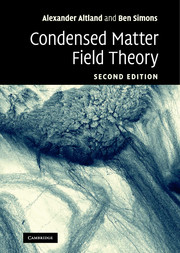Book contents
- Frontmatter
- Contents
- Preface
- 1 From particles to fields
- 2 Second quantization
- 3 Feynman path integral
- 4 Functional field integral
- 5 Perturbation theory
- 6 Broken symmetry and collective phenomena
- 7 Response functions
- 8 The renormalization group
- 9 Topology
- 10 Nonequilibrium (classical)
- 11 Nonequilibrium (quantum)
- Index
10 - Nonequilibrium (classical)
Published online by Cambridge University Press: 04 August 2010
- Frontmatter
- Contents
- Preface
- 1 From particles to fields
- 2 Second quantization
- 3 Feynman path integral
- 4 Functional field integral
- 5 Perturbation theory
- 6 Broken symmetry and collective phenomena
- 7 Response functions
- 8 The renormalization group
- 9 Topology
- 10 Nonequilibrium (classical)
- 11 Nonequilibrium (quantum)
- Index
Summary
This chapter provides an introduction to nonequilibrium statistical (field) theory. In the following, we introduce a spectrum of concepts central to the description of many particle systems out of statistical equilibrium. We will see that key elements of the theory – Langevin theory and the formalism of the Fokker–Planck equation – can be developed from the coherent framework of a path integral formalism. Applications discussed below include metastability, macroscopic quantum tunneling, driven diffusive lattices, and directed percolation. While the emphasis in this chapter is on classical nonequilibrium phenomena, the quantum theory of nonequilibrium systems will be discussed in the next chapter.
The world is a place full of nonequilibrium phenomena: an avalanche sliding down a sandpile, a traffic jam forming at rush hour, the dynamics of electrons inside a strongly voltage-biased electronic device, the turmoil of markets following an economic instability, the diffusion-limited reaction of chemical constituents and many others are examples of situations where a large number of correlated constituents evolves under “out-of-equilibrium” conditions. Statistical nonequilibrium physics is concerned with the identification and understanding of universal structures that characterise these phenomena. Notwithstanding the existence of powerful principles of unification, it is clear that a theory addressing the dazzling multitude of nonequilibrium phenomena must be multi-faceted. And indeed, nonequilibrium statistical physics is a strongly diversified field comprising many independent sub-disciplines. But this is not the only remarkable feature of this branch of physics.
- Type
- Chapter
- Information
- Condensed Matter Field Theory , pp. 602 - 692Publisher: Cambridge University PressPrint publication year: 2010

